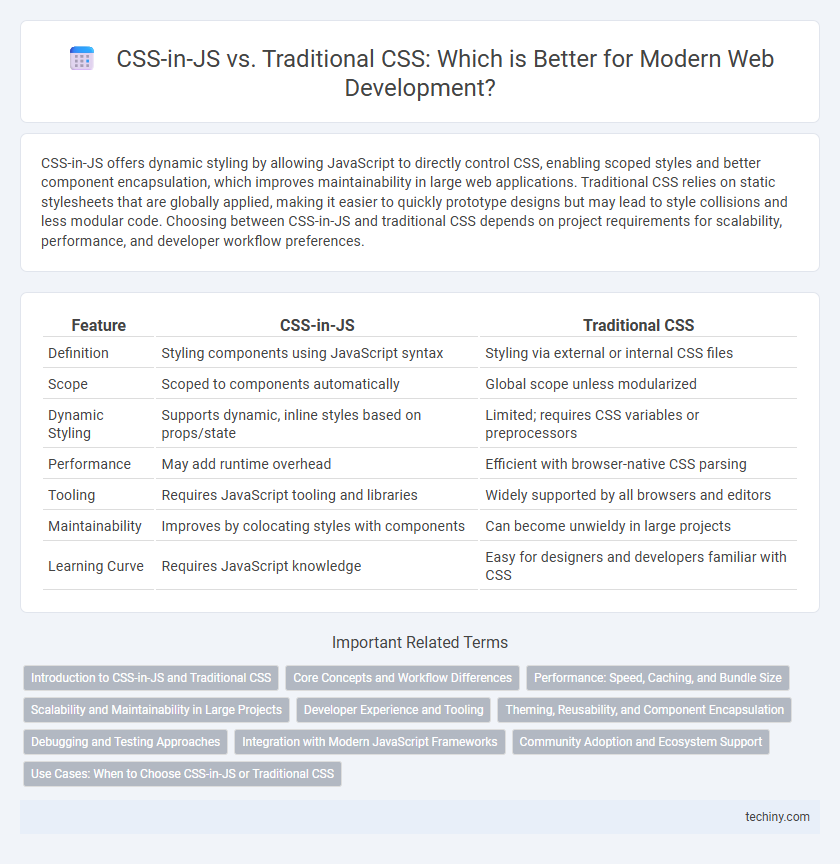CSS-in-JS offers dynamic styling by allowing JavaScript to directly control CSS, enabling scoped styles and better component encapsulation, which improves maintainability in large web applications. Traditional CSS relies on static stylesheets that are globally applied, making it easier to quickly prototype designs but may lead to style collisions and less modular code. Choosing between CSS-in-JS and traditional CSS depends on project requirements for scalability, performance, and developer workflow preferences.
Table of Comparison
| Feature | CSS-in-JS | Traditional CSS |
|---|---|---|
| Definition | Styling components using JavaScript syntax | Styling via external or internal CSS files |
| Scope | Scoped to components automatically | Global scope unless modularized |
| Dynamic Styling | Supports dynamic, inline styles based on props/state | Limited; requires CSS variables or preprocessors |
| Performance | May add runtime overhead | Efficient with browser-native CSS parsing |
| Tooling | Requires JavaScript tooling and libraries | Widely supported by all browsers and editors |
| Maintainability | Improves by colocating styles with components | Can become unwieldy in large projects |
| Learning Curve | Requires JavaScript knowledge | Easy for designers and developers familiar with CSS |
Introduction to CSS-in-JS and Traditional CSS
CSS-in-JS integrates CSS directly within JavaScript, allowing dynamic styling and scoped components, which enhances maintainability and reduces style conflicts. Traditional CSS maintains a separation of concerns with styles defined in external files loaded globally or modularly through preprocessors like Sass. Understanding these approaches helps developers choose between the flexibility of JavaScript-driven styles and the simplicity and performance of conventional stylesheet management.
Core Concepts and Workflow Differences
CSS-in-JS integrates styling directly within JavaScript files, enabling dynamic styles and scoped components, which contrasts with Traditional CSS's separation of style definitions in external stylesheets. In CSS-in-JS, styles are often generated at runtime based on component props or state, streamlining the workflow by reducing context switching between files and improving maintainability through encapsulation. Traditional CSS relies on static selectors and cascading rules loaded globally or modularly, requiring careful class naming conventions and stylesheet management to avoid conflicts and ensure style consistency.
Performance: Speed, Caching, and Bundle Size
CSS-in-JS enhances performance by dynamically injecting styles, reducing unused CSS and improving initial load speed compared to traditional CSS files that often include bulky, global styles. Its scoped styling approach optimizes caching by generating unique class names tied to specific components, minimizing cache invalidation and improving runtime efficiency. Traditional CSS benefits from browser-level caching and smaller bundle sizes when properly modularized but can suffer from style recalculation overhead and specificity conflicts affecting overall speed.
Scalability and Maintainability in Large Projects
CSS-in-JS enhances scalability and maintainability in large web development projects by enabling modular, component-scoped styling that reduces style conflicts and simplifies code management. Traditional CSS, while widely supported, often leads to global namespace issues and requires stringent conventions like BEM for maintainability at scale. Leveraging CSS-in-JS frameworks such as Styled Components or Emotion streamlines updating styles alongside JavaScript logic, improving developer productivity and project extensibility.
Developer Experience and Tooling
CSS-in-JS enhances developer experience by enabling scoped styles, reduced stylesheet bloat, and seamless integration with JavaScript frameworks like React, improving maintainability and dynamic styling capabilities. Traditional CSS benefits from mature tooling including extensive pre-processors (Sass, Less) and widespread browser compatibility, offering simplicity in style management for static and large-scale projects. Developers opting for CSS-in-JS gain the advantage of runtime style manipulation and component-level encapsulation, while those choosing traditional CSS leverage faster initial render times and a more straightforward debugging process.
Theming, Reusability, and Component Encapsulation
CSS-in-JS enables dynamic theming by allowing styles to be directly manipulated through JavaScript variables, enhancing reusability and theme consistency across components. Traditional CSS relies on static stylesheets with selectors that can lead to style collisions and challenges in maintaining encapsulated component styles. Component encapsulation is stronger in CSS-in-JS due to scoped styling within components, reducing global namespace conflicts and improving maintainability in modern web development.
Debugging and Testing Approaches
CSS-in-JS enhances debugging by enabling component-scoped styles and providing clearer traceability within JavaScript stack traces, reducing style conflicts common in traditional CSS. Testing in CSS-in-JS frameworks integrates seamlessly with JavaScript testing tools like Jest and React Testing Library, allowing style verification alongside component behavior. Traditional CSS relies on separate style linting and visual regression testing tools, which can complicate debugging due to global scope and cascading issues.
Integration with Modern JavaScript Frameworks
CSS-in-JS offers seamless integration with modern JavaScript frameworks like React, Vue, and Angular by enabling styling directly within component files, which enhances modularity and scope isolation. Traditional CSS requires separate stylesheet management and manual class naming, often leading to style conflicts and less maintainable codebases in large-scale applications. Leveraging CSS-in-JS simplifies dynamic styling, supports theme management, and improves developer workflow by aligning styles closely with component logic.
Community Adoption and Ecosystem Support
CSS-in-JS libraries like Styled Components and Emotion have seen rapid community adoption due to their seamless integration with JavaScript frameworks such as React, offering dynamic styling capabilities that traditional CSS lacks. Traditional CSS benefits from decades of ecosystem support, including extensive tooling, browser compatibility, and a vast array of prebuilt frameworks like Bootstrap and Tailwind CSS. Developer preference often hinges on project requirements, with CSS-in-JS favored for component-scoped styles and maintainability, while traditional CSS remains dominant in legacy projects and scenarios demanding global style management.
Use Cases: When to Choose CSS-in-JS or Traditional CSS
CSS-in-JS excels in dynamic styling for React or Vue components, enabling scoped styles and runtime theming ideal for highly interactive or modular applications. Traditional CSS suits static websites or projects prioritizing global styles and ease of maintenance through separate style sheets, benefiting teams using standard CSS preprocessors like SASS or LESS. Choosing between CSS-in-JS and traditional CSS depends on project complexity, team workflow, and the need for dynamic versus static styling solutions in web development.
CSS-in-JS vs Traditional CSS Infographic

 techiny.com
techiny.com